On the recommendation of pediatricians, vegetable purees are introduced into the menu of babies after 6 months. Boiled beets should appear in the child's diet a little later. This vegetable has a lot of useful properties, but with early or incorrect acquaintance with it, the body of a newborn can be harmed. At what age and in what form should beets be given to the baby? To answer this question, you need to find out how this root crop acts on the child's body.
The benefits of beets for children
Beets contain many useful to the child vitamins and other chemical elements. This root crop is perfectly stored throughout the year, so it is especially important in spring and winter, when there is not enough fresh vegetables and fruits. For children highest value have the following useful qualities of this vegetable:
- high content of fiber, which normalizes stools, increases appetite and maintains a healthy bowel;
- a sufficient amount of vitamins A, C, E, K, folic acid, calcium, magnesium, potassium, without which the normal development of a child of any age is impossible;
- the presence of antioxidants that reduce the risk of developing cardiovascular diseases;
- the ability to stimulate the production of red blood cells due to the high concentration of iron in the composition, which is very important for the development of the brain of children, especially the first year of life;
- the content of betaine - a plant compound that protects the children's liver;
- the presence of pectin acids acts as a laxative for babies suffering from constipation.
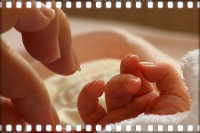
What is harmful beets for babies?
Despite all beneficial features root crop, give it to the child as the first vegetable complementary foods it is forbidden. Beets can provide harmful effect for a newborn:
- it has the ability to accumulate nitrates absorbed in large quantities from the soil, with which the child's body can easily be poisoned;
- the root crop itself and its juice often cause allergies in children;
- excessive consumption of beets can cause diarrhea in the baby.
However, the harm of this vegetable can be minimized if you adhere to simple rules. The product must be given to the baby only in the amount recommended by doctors for his age. It is best to include beets from your own garden in your child's diet. If this is not possible, you should choose small maroon roots without light veins on the cut. These signs indicate that the vegetable contains a minimum amount of nitrates. You should know that newborns are given only heat-treated beets.
Harmful for babies and freshly squeezed beetroot juice. This drink is very useful for adults, but for baby food he doesn't fit. Beetroot juice contains a lot of fruit acids, which irritate the delicate lining of the stomach and intestines of a newborn. In addition, the juice is not subjected to heat treatment, so it contains a lot of nitrates. After a year, with a tendency to constipation, pediatricians recommend giving up to 60 ml of such a drink per day to a baby, be sure to dilute it with water.

Suitable age for beetroot feeding
From what month can you feed your baby with beets? Most pediatricians recommend giving this root vegetable to babies after they reach 8 months. First, boiled beets in the form of mashed potatoes are included in the child's menu. The first serving should not exceed half a teaspoon. It is better to give beets to a child in the morning, in order to easily track the reaction of his body to New Product. With normal tolerance of the vegetable, the portion can be increased daily by ½ teaspoon, gradually bringing the total volume to 5 teaspoons per day. If the baby is not prone to constipation, it is enough to feed him beetroot puree twice a week.
For a child who has had problems with stools (constipation) since birth, the doctor may prescribe beetroot complementary foods from the age of 5 months. To achieve a laxative effect for a newborn in six months, 1 teaspoon of puree is enough. In agreement with the pediatrician, for the same purposes, beet juice can be given to the baby. A child who is prone to allergies or suffers from intestinal colic, you can not give beets and juice from it for at least 12 months.
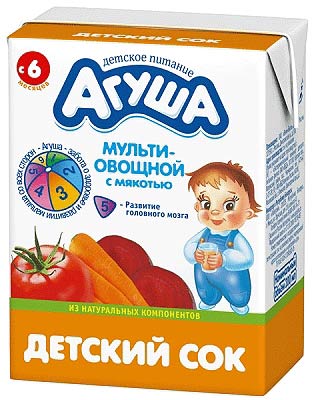
In what form should beets be introduced into the children's diet?
Raw root vegetables contain more vitamins, but only boiled beets are suitable for feeding babies. A thermally unprocessed vegetable has a strong irritant effect and often causes allergies. When the beets are boiled, some of the vitamins are destroyed, but the amount of fruit acids that adversely affect the baby also decreases. digestive system. In addition, during the cooking process, almost all nitrates pass into beetroot broth. The most useful elements for children: fiber, pectin, betaine, iron, magnesium and some others are preserved.
How to cook beets for a child? It is necessary to lower a small root crop into boiling water, after cutting off its upper part, where the largest amount of nitrates accumulates. You don’t need to add salt: firstly, the vegetable will cook longer in salt water, and secondly, it is not recommended to add salt to food for children of the first year of life. When 40 minutes have passed, remove the beets with a slotted spoon and place them in ice water for 20 minutes. Thanks to this trick, the root crop will become soft even after a short boil.
You can not feed the child only beetroot puree. Boiled beets should make up no more than 30% of the total volume of the dish. You can mix it with other vegetables: zucchini, potatoes, cabbage, pumpkin. By 12 months, a child should receive no more than 12 teaspoons of beets per day.
After a year, the baby can be offered different dishes based on beets. Children like vinaigrette, beetroot soup, casserole, stew, beetroot salad, beetroot fritters. It is better to include boiled or steamed dishes in the child's diet. When the baby is 12 months old, he can also receive beetroot juice in moderation. Advice
If you are concerned about your child's reaction to these foods, consult your pediatrician.
In ancient times, this amazing root crop was used not only as a tasty and healthy food, but also as a blush for the face. Guess what we're talking about today? Of course, it's beets.
The beneficial properties of beets have been valued for a long time.
About good
From time immemorial, this vegetable has been famous for its beneficial properties, which include:

About the bad
However, beetroot can be harmful to health, because it is a vegetable (just like all greens and collard greens), actively collecting amides, nitrates and ammonium salts from the soil. The result of the use of a root crop rich in harmful substances can be a violation of the functioning of the kidneys. This vegetable also has the ability to lower blood pressure. This feature is beneficial for some adults who have problems with cardiovascular disease, but is completely unnecessary for a small child.
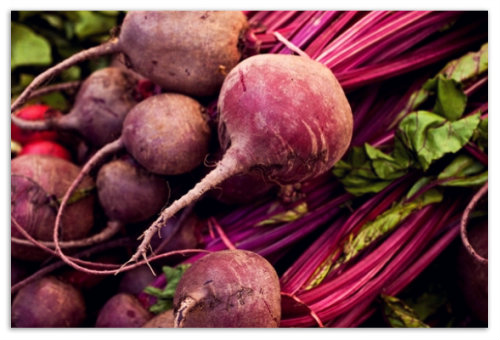 Beets can cause some harm to the crumbs that have not yet grown stronger.
Beets can cause some harm to the crumbs that have not yet grown stronger. Suffering from diathesis
In this case, is it possible for a child to have beets? It is possible and necessary, but portions should be strictly metered not only because of the above negative factors, but also because allergies can happen. Children who have already had problems with diathesis should not introduce this valuable vegetable into complementary foods before a year.
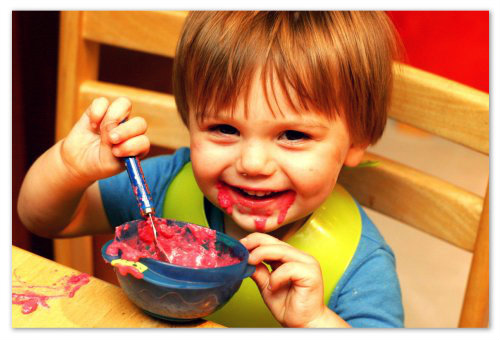 Babies with diathesis will be able to taste beets only after the first year of life.
Babies with diathesis will be able to taste beets only after the first year of life. Now you can try
At what age should we start feeding beets so as not to harm the baby? A vegetable is usually introduced into the diet after the crumbs have met potatoes (before that, the child tries carrots).
The approximate age of the baby is 8-9 months. Allergy sufferers - strictly after a year in minimal quantities and carefully observing the reaction to the product. If the crumbs have constipation with an enviable frequency, then you can start beetroot complementary foods a little earlier than the age indicated by the norm, but not the first course and not until the baby reaches six months.
If you are not very concerned about the introduction of any complementary foods or do not have strong doctor's indications for the use of this particular root crop, then you can wait up to a year with beets. A one-year-old baby is already slightly adapted to adult food, and such a serious and fiber-rich vegetable will perceive much better than an 8-9 month old baby.
 The body of grown children takes beets much better.
The body of grown children takes beets much better. How to introduce beets into the diet? You need to start with microscopic doses of juice from boiled vegetable. The best option will add a few drops of well-cooked beetroot juice to vegetable puree with whom the baby is already familiar and friendly. Be sure to observe the child's reactions to the new product (changes in stool, signs of allergies). If at least one of them manifests itself, then it is worthwhile to wait a couple of months with beetroot complementary foods. If you decide to start complementary foods with this root crop from 9 months, then it the volume should not exceed 1/3 of the total mass of the dish. By the age of one, a child can eat up to 50 grams of a red vegetable per day (but no more). It is enough to feed the baby beets once a week.
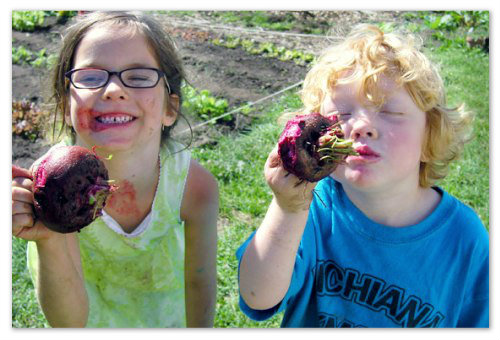 Beets require gradual getting used to yourself.
Beets require gradual getting used to yourself. Only fresh product
Beets are a great addition to cereals: buckwheat, oatmeal and rice. You can cook these cereals in a diluted root vegetable decoction (if you are sure that there are no nitrates) or simply add beetroot puree to an already prepared porridge.
The vegetable should only be fresh or freshly cooked because, when reheated, substances harmful to the baby are formed in it.
Raw vegetable: is it possible?
Beetroot juice (raw) can be given at the same age, but only in a diluted state (either with boiled water or as an additive in other juices). Such measures are taken because the juice has an unpleasant aftertaste and in its pure (concentrated) form irritates the mucous membranes of the stomach and intestines of the crumbs. Beetroot juice in the total amount of drink consumed by the baby should not contain more than 1/3 of the total volume. If possible, then it is better to wait with juice for up to a year because all the substances (and harmful ones too) that are in a vegetable are also present in its juice, only in a more concentrated form than in a boiled root crop.
 Undiluted beetroot juice is unpalatable and bad for baby's delicate stomach.
Undiluted beetroot juice is unpalatable and bad for baby's delicate stomach. note
- Suffering from any disease of the stomach;
- Has kidney problems
- Prone to diarrhea;
- Suffering from diabetes.
When a child is sick, it is always a tragedy for his parents. And if the baby has alarming symptoms, this is doubly scary. Moms panic if. What to do?
Many babies suffer from lactose intolerance, which greatly complicates the feeding process. What to do if your child has been given a disappointing diagnosis, read on.
Here comes the year
The child's menu after a year, including beets, becomes more diverse:
- stew;
- borscht;
- salads;
- soups.
In each of the listed dishes, the vegetable we are discussing can only be an addition, but by no means the dominant component. Children from one to 7 years old can be given up to 100 grams of root crop per day (provided that the child does not suffer from diarrhea).
 Beetroot is a useful component that brings variety to the traditional dishes of the child.
Beetroot is a useful component that brings variety to the traditional dishes of the child. Cook, bake or eat raw?
If we compare the benefits of eating raw and boiled (or baked) vegetables, then, oddly enough, there will be more of it from a thermally processed root crop. During cooking and baking, part of the vitamins is lost, the effect of irritation of the mucous membranes is reduced and nitrates disappear, and fiber remains, all trace elements, pectin (frees the body from bad substances and impurities) and betaine - a substance that slows down the aging process and has a beneficial effect on the activity of the brain and liver. IN raw beets all substances are in an unchanged state, but due to the presence of nitrates and the irritating property of juice, it can cause harm in much larger volumes than its cooked counterpart.
Puree
The simplest beetroot dish for a baby is mashed potatoes. Its recipe is also simple. We will need:
- the vegetable itself;
- water;
- sunflower oil.
Cooking scheme:
- My vegetable, removing particles of earth, small roots and green tops.
- Pour in water, bring to a boil and cook for about 10 minutes.
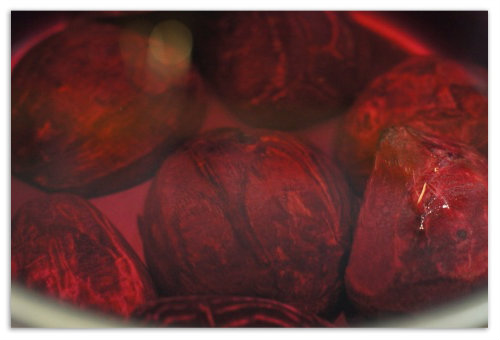 Cooking beets will take a lot of time.
Cooking beets will take a lot of time. - We drain the water and fill it with new water.
- Cook over low heat in a saucepan with a closed lid for about 1.5 hours (depending on the size of the root crop).
- Dip the prepared beets for a few minutes in cold water(to easily remove the peel).
- Rub the peeled vegetable on a fine grater.
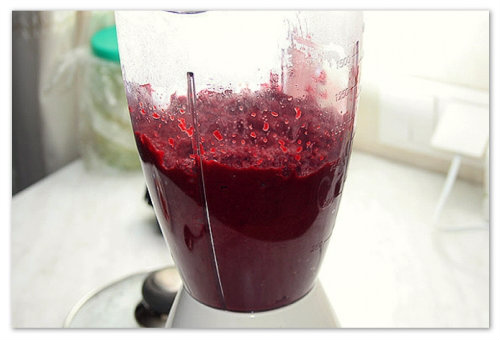 A blender will also do an excellent job of chopping beets.
A blender will also do an excellent job of chopping beets. - Add a little sunflower oil.
- Mix and add another 2-3 tablespoons of boiled water or vegetable broth (to dilute the resulting thick puree).
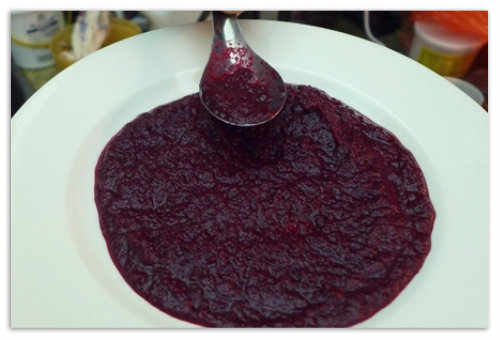 The kid will appreciate it!
The kid will appreciate it! - Mix everything well and offer the baby.
This recipe is suitable for children up to a year.
How much sleep should a newborn baby have? We will talk in detail about the issues of sleeping babies on this page.
Salad
Older kids may like beetroot salad with prunes. The recipe is also very simple.
Ingredients:
- boiled beets (one is enough);
- a few prunes;
- a couple tablespoons of sour cream.
How to cook:
- We boil the vegetable.
- Three peeled root crops on a grater.
 One small beetroot for a baby will be more than enough.
One small beetroot for a baby will be more than enough. - Cut the washed prunes into small pieces and add to the beets.
 For beets, you can pick up any ingredient that the child prefers.
For beets, you can pick up any ingredient that the child prefers. - Mix the salad, season with sour cream and mix again.
You can experiment and add an apple and (or) carrot instead of prunes. The main ingredient of the salad can be raw (if the baby perceives it normally). Some kids like to eat soup with a slice of beets in the bite. Many children like beetroot pancakes - here you should already see what suits your little one more.
Do not be alarmed if, after eating pancakes or salad, urine or feces little man become pink or reddish in color - this is completely normal.
The Right Vegetable
About what the beets should be. It is best to grow a miracle vegetable in your beds. If you do not have the ability or desire to do this, then you need to know a few points about what ideally purchased beets should be.
- Do not buy large vegetables - they contain much more harmful substances than small or medium root crops.
 Small beet root crops are most useful for a child.
Small beet root crops are most useful for a child. - Choose vegetables only with a pronounced burgundy color - it indicates the quality of the root crop.
- Ask the seller (if possible) to cut one of the root crops. If light streaks are visible on the cut, then such a product is not suitable for a child to eat.
 Light streaks are a guarantee of quality.
Light streaks are a guarantee of quality. We fight with a cold
With the help of beets, you can. Effective as raw vegetable, and boiled. For treatment, you need juice, which is instilled into the nasal passages. The child may react painfully to this natural medicine, so the juice must be diluted in half with water (boiled). The juice can be successfully combined with honey or carrots. The solution is instilled 2-3 drops into each nasal passage up to 4 times a day.
 Diluted beetroot juice will quickly help with a runny nose.
Diluted beetroot juice will quickly help with a runny nose. Pages of life
“How many times I went shopping, I never saw baby food that contained beets. The son suffers from constipation from cereals and mixtures. Today, quite by accident, I stumbled upon "Grandma's Basket". They make beef with beets. Hooray! We tried and, it seems, "hooked" on this dish. Maksimka gobbles up both cheeks. I must say that we are completely artificial. Now my son is 7.5 months old. We'll see if there's a rash tomorrow."
“Mommies, you’ve already gone completely crazy: to poison children with store-bought stuff! There are also a lot of preservatives, and then you have eyes wild with surprise: where did the child suddenly have an allergy? Every baby knows for himself what and when he needs to introduce complementary foods. If everything is correct, then the child smiles and grabs the spoon himself, and if he refuses, it is too early for this food. With beets, everything is very individual! Moms, keep an eye on your kids. Only they will show the right way.”
“I am against store packaging. There you can find anything at all, except for what should be there. Poison - just spit. I cook all the food myself at home. I give my daughter boiled beets and rubbed through a sieve. I cook for about half an hour, after cutting into cubes. As long as she likes it."
Summarizing the information in the article:
- Beets can bring both benefit and harm.
- It must be introduced into the diet very carefully.
- According to indications, you can start complementary foods with vegetables from 6 months.
- At normal development child, his first acquaintance with the root crop occurs closer to 9 months.
- Babies with obvious signs of diathesis can eat beets only after a year.
- A boiled vegetable is healthier than a raw one.
- For a child, you need to carefully choose root crops.
- Beets are a folk-tested remedy for the common cold.
Beetroot is a vegetable that should be included in complementary foods with particular care. It can both heal the child's body and cause him serious harm. How competently complementary foods will be organized largely depends on how the child will be able to use this product in the future. It is possible to be allergic to it, so puree or juice from it is dangerous for newborns.
Why is beetroot useful?
Children benefit from beets for a number of reasons.
First, it contains a large amount of fiber and pectin. These ingredients are especially necessary for the baby with regular constipation ( frequent occurrence in children of the first year of life, when the intestinal microflora is not yet fully formed).
It is noteworthy that, unlike other vegetables with a laxative effect, beets do not provoke flatulence, do not cause spasms, have the most mild effect and do not cause discomfort to the child.
Secondly, it contains many vitamins (ascorbic acid, PP, group B) and minerals (zinc, iron, iodine, copper, calcium and potassium, magnesium) valuable for the growth of a child of any age. The valuable composition of beets contributes to the normal growth of the child's body, this complex is necessary for children for physical and mental development It has a beneficial effect on the immune system.
Thirdly, the characteristic shade of beets is provided by betaine, a biologically active substance that takes part in the synthesis of proteins and fats.
Fourthly, it is useful to give beets to children suffering from excessive nervous excitability. It also helps to strengthen blood vessels, has a beneficial effect on blood composition (increases hemoglobin levels, normalizes glucose levels).
How and to whom can it harm?
Beets are contraindicated for a child who often has diathesis on new foods introduced into complementary foods. You may be allergic to beets. It is characterized by the appearance of a rash on the baby's face, loss of appetite, upset stool.
The specificity of the growth of this root crop is such that it actively collects nitrates, ammonium salts and amides from the soil, subsequently infecting the human body with them. For this reason, when choosing beets for a child, pay attention to which region of the country it was imported from.
With the use of beets in people of any age, there is a sharp decrease blood pressure. This characteristic is useful for adult cardiologist patients, but little child She can only hurt.
With extreme caution, it is necessary to give this vegetable to the following categories of children:
- diabetics
- those with kidney problems
- suffering from frequent indigestion
At what age should babies be introduced into the diet?

Children under one year old can be introduced to this product from about 8 months. At this time, the classic complementary foods are replenished with potatoes, and the baby’s stomach is already free to cope with zucchini, broccoli, and cauliflower.
It is best to give the baby the juice of this root crop, and not in its pure form, but dilute it mashed potatoes or cereals (buckwheat, oatmeal, rice). Introducing beetroot juice into the baby's menu should start with half a teaspoon, carefully monitoring the baby's reaction to the new ingredient.
If the baby has a food allergy, complementary foods should be postponed until at least his year. It is necessary to introduce a new ingredient into the menu of such a child very carefully.
If after a year mom is still practicing breast-feeding, at first you can try the beets for yourself: part of the woman’s diet will also be transferred to the baby with milk.
You can start introducing beetroot juice or vegetable puree with this ingredient earlier in infants who suffer from regular constipation. To normalize the baby's stool up to a year, it is enough to give him dishes with this root crop once a week. When the baby is one year old, he can already be offered 50 grams of beetroot puree.
Beetroot juice from a fresh root vegetable is too concentrated a drink for an infant. It must be diluted with purified water in a ratio of 1:3. For these purposes, you can use any other vegetable juice, for example, pumpkin. By itself, beetroot juice has a rather specific taste, therefore, in order for the child to agree to drink it, it can and should be given with other products.
How to feed beets to a child older than a year?
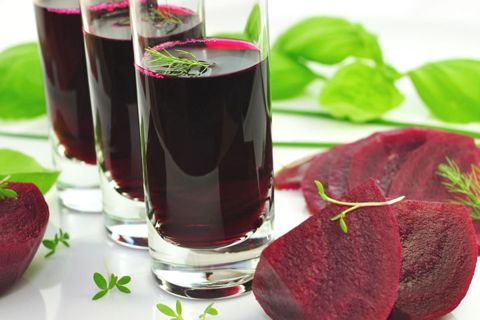
After a year, the baby's body is ready to accept multicomponent dishes. At this age, he can already be given not just beetroot juice or a simple puree of several vegetables, but more complex dishes: beetroot, vegetable salad, smoothies. Which dish to start with depends on how the baby perceives already adult food and how competently complementary foods were introduced to him.
Beetroot puree for a baby of the second year of life can no longer be whipped to a mushy consistency. Children of this age usually already have several teeth, so they will be able to chew larger pieces on their own. To prepare mashed potatoes, it is better to bake beets in the oven or steam them, then add a little vegetable oil.
If we compare the benefits of a raw root crop and a heat-treated one, then the latter wins. During cooking, some of the vitamins are destroyed, but fiber, trace elements, betaine are preserved.
In a boiled (stewed, baked) form, beets do not irritate the walls of the stomach as much as a fresh vegetable. In addition, it is important for children who are a year old to cook a variety of dishes, and with thermally processed beets it is much easier.
In especially difficult cases associated with constipation, the baby can prepare a salad of beets and prunes. Both of these ingredients have a laxative effect and pair well with each other in taste.
If beets were not introduced to the baby in complementary foods, because. there was an allergy, you can try to do it again after a year. An allergy could be provoked by the fact that the stomach could not yet digest this heavy food for it on its own.
At what age to offer beetroot puree to a baby depends on the state of his health. For children without developmental pathologies, it is optimal age 8-9 months. This product may be allergic, so children suffering from diathesis, it is contraindicated for at least a year. Allergy is a serious test for a growing organism, so potential allergens in children's menu should appear as soon as possible.
How to lose weight after childbirth?
How to lose weight after childbirth?
Many women after childbirth face the problem of the appearance excess weight. For some, they appear during pregnancy, for others - after childbirth.
- And now you can no longer afford to wear open swimsuits and short shorts ...
- You start to forget those moments when men complimented your flawless figure...
- Every time you approach the mirror, it seems to you that the old days will never return ...
Is beetroot good for children or not? Previously, this question was not in doubt. Beets were considered unconditionally useful product. Now there are different opinions about this.
Beets for children Advantages
Beets are a very healthy vegetable.
- 100 g of beets contain approximately 4 g of fiber, as well as potassium, magnesium, which explains its laxative effect.
- Beets contain the substance betaine, which belongs to the group of phospholipids, improves the functioning of the liver and brain, and slows down aging.
- Beets contain organic nitro compounds that dilate blood vessels and increase endurance.
- Beets contain pectin, which removes harmful substances, toxins, salts of heavy metals from the body.
- It contains many vitamins and microelements.
Beets for children Disadvantages
- Beets, along with herbs (parsley, dill, lettuce, kale, green onions) and watermelons, belong to the group of vegetables with a high content of nitrates. It actively absorbs them from the soil and accumulates. When eating beets, especially in large quantities, there is a risk of poisoning with nitrates. The first signs of such poisoning are nausea, vomiting, dizziness. Therefore, for a child, you need to choose environmentally friendly beets and give them in moderation.
- Beets often cause allergies, so you need to introduce it into the child's diet with caution.
- Beetroot has a pronounced laxative effect, with its excess, diarrhea may develop. Therefore, the total amount of beets in the diet is limited.
Output
Beetroot is useful for a child if it is an environmentally friendly beetroot in an amount corresponding to the age of the child.
Question: is it possible for children to have beets, most of all worries those parents whose children are prone to. The laxative property of beets is widely known. And that is especially true for children. Its other useful properties are more important for adults.
In the nutrition of children, beets can be successfully used as a laxative to normalize stools. It is quite possible to give beets to healthy children in the amount recommended by age.
Beets for children How to choose beets?
The ideal option is beets from your garden. It is also a good idea to have a device at home to measure the content of nitrates in products. If this is not possible:
- You need to choose medium-sized or small beets, large beets contain more nitrates,
- Beets should be maroon in color, too pale color can also be a sign of high nitrate content,
- If it is cut, there should be no light streaks on the cut.
Which beets are healthier for children, raw or boiled?
Raw beets contain more vitamins, but at the same time more nitrates and have a pronounced irritant effect on the gastrointestinal tract, due to the content of fruit acids in it.
During cooking, part of the vitamins is destroyed, but fruit acids are also destroyed, most of the nitrates pass into the decoction during cooking. All trace elements, as well as fiber, betaine, pectin, are preserved in boiled beets.
Output
Boiled beets are healthier.
 beetroot juice
beetroot juice
Raw beetroot juice contains all the same useful and harmful substances as in beets, only in a higher concentration and in a state dissolved in water. Therefore, all effects after drinking the juice occur faster and are much more pronounced than after ordinary boiled beets.
When raw beetroot juice is consumed by a healthy adult on an empty stomach in large quantities, nausea, vomiting, dizziness up to fainting, diarrhea may occur. Beetroot juice has a pronounced vasodilating and diuretic effect, therefore it can cause a sharp drop in blood pressure. The laxative effect of the juice is also stronger than that of boiled beets.
Beetroot juice is not very pleasant in taste and not everyone can drink it undiluted.
Healthy adults are allowed to consume no more than 100 ml of raw beet juice per day, it is recommended to use it not on an empty stomach, but as an addition to other dishes, in addition, it is more useful to drink not pure beet juice, but mix it with other types of juices in a ratio of 1: 2 , later, as you get used to 1:1.
Beets for children as complementary foods
When and how to give a child beets?
- Acquaintance of a child with beets is best to start with mashed potatoes (from boiled beets).
- Beetroot is never the first (they don’t start with it), because it is a difficult to digest and quite allergenic product, it is added to the child’s diet after the introduction of other vegetables (zucchini, potatoes, carrots, pumpkin, cabbage, onions), as one of vegetable puree ingredients.
- Subject to all, beets appear in the diet of a healthy child from 8-9 months. But according to indications (for constipation), it can be preferred to some other vegetables and fruits. It is allowed to give the child puree and juice from beets from 6 months.
- It is introduced gradually, like other types,
- It should not be more than 30% of its total volume in the puree (about 60 g of beets or 12 teaspoons per day by 1 year).
- Beetroot goes well with cereals: oatmeal, rice, buckwheat. Therefore, you can cook on beetroot broth or add beetroot puree to porridge.
- It is recommended to give the child only freshly prepared puree, because. when reheated, nitrite salts toxic to the child are formed in it.
- Freshly squeezed juice from beets is recommended for a child from 8-9 months, it is allowed not earlier than 6 months. Personally, I prefer boiled beet puree, and juice is better after a year.
- Its introduction into the diet should be treated even more carefully and introduced even more gradually, you can start with drops. It is better to treat beetroot juice as a medicine, and select the dose for the child individually.
- Beetroot juice is not recommended to be given in its pure form because of the not very pleasant taste and irritating effect on the gastrointestinal tract. It is more useful to mix it with other juices. (apple, carrot, pumpkin), the proportion of beets should not exceed 20-30% (by 1 year - 30 g / day or 5-6 teaspoons).
How to cook?
- Most of all, nitrates accumulate in the upper part of the beet, where the tops grow from, it is better to cut this part of the beet deeper.
- For baby food, boiled beets are preferable, because. during the cooking process, 80% of the nitrates go into the broth.
- Beets for baby puree you need to wash, peel, cut, put in a saucepan, pour water, bring to a boil, cook for 5-10 minutes, then drain the water. Pour water over the beets again, add other vegetables or cereals to it and cook until tender.
 Ready-made purees and juices with beets
Ready-made purees and juices with beets
Many parents think that there are no ready-made baby purees and juices with beets. This alarms them, they begin to doubt that beets are suitable for complementary foods.
In fact, there are no only monocomponent ready-made purees and juices from beets. Most baby food manufacturers include beets in multi-vegetable juices, purees, cereals and other products as one of the components, i.e. follow all the recommendations related to beets as a complementary food dish.
 There are for example
There are for example
- Agusha juice - tomato, carrot, beet - from 6 months,
- Frutonyanya juice - carrots, celery, beets, cucumbers, white cabbage - from 6 months,
- Puree Babushkino basket - beef, beets - from 6 months,
- Borsch with beef Heinz - from 8 months,
- Humana puree with blueberries and strawberries, with the addition of beetroot juice 2.4% - from 6 months,
- Dry porridges of Humana and Hipp containing beetroot powder.
Beets are especially useful for children
- constipated,
- overweight,
- during convalescence after acute illness.
It is better not to give beets to a child under 1 year old if he suffers
- prone to allergies,
- diarrhea, flatulence, intestinal colic,
- kidney disease,
- oxaluria.
Beets for children over a year old
After a year, beetroot dishes can be more varied: salads, soups, borscht, stews, etc. It is still better to use beetroot as an addition to other dishes, and mix beetroot juice with other juices.
The total amount of boiled (baked) beets in the diet of a child under 7 years old is not more than 100 g per day, over 7 years old and an adult is not more than 150 g. 1.5 times less.
Beetroot stains the urine and feces of the child red or pink. It is absolutely safe for the child. Beets contain a lot of coloring pigment, which is widely used in the food industry as a dye.
